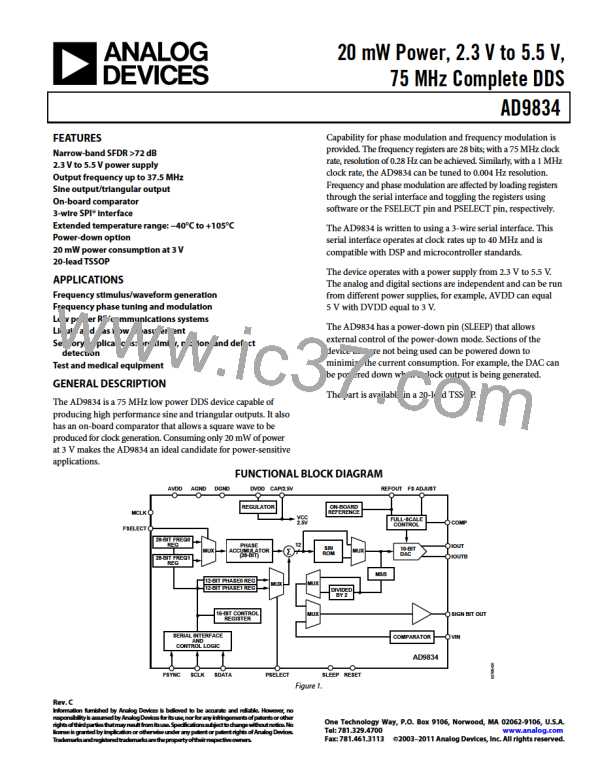AD9834
TERMINOLOGY
spur relative to the magnitude of the fundamental frequency in
the 0 to Nyquist bandwidth. The narrow-band SFDR gives the
attenuation of the largest spur or harmonic in a bandwidth of
200 kHz about the fundamental frequency.
Integral Nonlinearity (INL)
INL is the maximum deviation of any code from a straight line
passing through the endpoints of the transfer function. The
endpoints of the transfer function are zero scale, a point 0.5 LSB
below the first code transition (000 . . . 00 to 000 . . . 01), and full
scale, a point 0.5 LSB above the last code transition (111 . . . 10 to
111 . . . 11). The error is expressed in LSBs.
Total Harmonic Distortion (THD)
THD is the ratio of the rms sum of harmonics to the rms value
of the fundamental. For the AD9834, THD is defined as
Differential Nonlinearity (DNL)
2
2
2
2
2
V2 + V3 + V4 + V5 + V6
THD = 20log
DNL is the difference between the measured and ideal 1 LSB
change between two adjacent codes in the DAC. A specified
DNL of 1 LSB maximum ensures monotonicity.
V1
where V1 is the rms amplitude of the fundamental and V2, V3,
V4, V5, and V6 are the rms amplitudes of the second harmonic
through the sixth harmonic.
Output Compliance
The output compliance refers to the maximum voltage that can
be generated at the output of the DAC to meet the specifications.
When voltages greater than that specified for the output com-
pliance are generated, the AD9834 may not meet the
specifications listed in the data sheet.
Signal-to-Noise Ratio (SNR)
SNR is the ratio of the rms value of the measured output signal
to the rms sum of all other spectral components below the
Nyquist frequency. The value for SNR is expressed in decibels.
Spurious-Free Dynamic Range (SFDR)
Clock Feedthrough
Along with the frequency of interest, harmonics of the
fundamental frequency and images of these frequencies are
present at the output of a DDS device. The SFDR refers to the
largest spur or harmonic present in the band of interest. The
wideband SFDR gives the magnitude of the largest harmonic or
There is feedthrough from the MCLK input to the analog
output. Clock feedthrough refers to the magnitude of the
MCLK signal relative to the fundamental frequency in the
output spectrum of the AD9834.
Rev. C | Page 14 of 36

 ADI [ ADI ]
ADI [ ADI ]